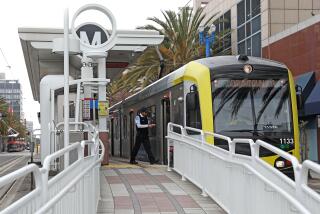Stray Current in Sidewalks Poses Hazard
- Share via
NEW YORK — Two years after a woman walking her dogs was electrocuted by stray current coursing through a utility panel in a Manhattan sidewalk, increased efforts in two cities to detect other hot spots have failed to stop people and animals from getting shocked.
Within the last few months, pedestrians and pets in both New York and Boston have been jolted by short circuits in the electrical panels commonly underfoot in big cities.
Among the casualties:
Four pedestrians were zapped Feb. 12 when they stepped on the metal lid of a service box near Times Square. Hannah Davis, 15, a model from the U.S. Virgin Islands, likened the shock to being shot with a stun gun.
On Wednesday, a dog in a wealthy section of Brooklyn got a fatal jolt from a circuit that once provided power to a street lamp.
Last month, a loose wire beneath a metal plate delivered a deadly shock to a dog in Boston. It was at least the fourth such electrocution of a dog in that city.
And in October, a New York sanitation worker reported receiving a minor jolt when he grabbed an umbrella that was touching an electrified light pole.
Authorities had hoped to halt such incidents with a raft of new regulations and safety procedures adopted after the Jan. 16, 2004, death of Jodie Lane, a graduate student electrocuted by a malfunctioning utility box.
New York utility Consolidated Edison agreed last summer to pay nearly $10 million to make sidewalks safer.
New regulations in New York state require annual safety checks at every point where current has the potential to electrify the sidewalk. Previously, only a quarter of those spots were tested annually.
Boston implemented a tougher testing regimen too and began installing 35,000 plastic plates intended to better insulate sidewalk circuitry.
All the extra testing hasn’t yet solved the problem.
A recent report by Consolidated Edison said it found and fixed more than 1,100 hot spots in the 730,000 pieces of equipment it tested last year. Most of the culprits were streetlights and traffic poles owned by the city.
Among the spots tested was the section of sidewalk that killed the dog in Brooklyn. At the time, no stray current was detected, but such tests -- conducted on foot by workers carrying hand-held wands -- aren’t foolproof, said Con Edison spokesman Chris Olert.
“The underground in the city is dynamic. It is always shifting,” he explained.
Subway vibrations can cause wires to jiggle loose. Frayed connections that pose no problem in the summer suddenly begin emitting current after snowstorms, when water laced with road salt seeps everywhere, providing a highly conductive path to the surface.
“We could potentially test one day, and this could develop the next,” Olert said.
Inspectors had also checked the spot in Boston’s Charlestown section that delivered a fatal shock in January to a 6-year-old Labrador mix named Killian.
City officials speculated that vibrations from truck traffic had caused a wire in the box to shift into contact with the metal cover, which was among those that hadn’t yet received a plastic protector.
Stray voltage isn’t a purely urban issue.
Several dairy farmers in Wisconsin and Idaho have sued power companies, contending that current from poorly maintained transmission lines spread to the ground and into metal farm equipment.
The voltage was too low to be noticed by humans, but enough to make the cows sick and hurt milk production, the farmers said. Some cases have led to hefty jury verdicts.
More to Read
Sign up for Essential California
The most important California stories and recommendations in your inbox every morning.
You may occasionally receive promotional content from the Los Angeles Times.













